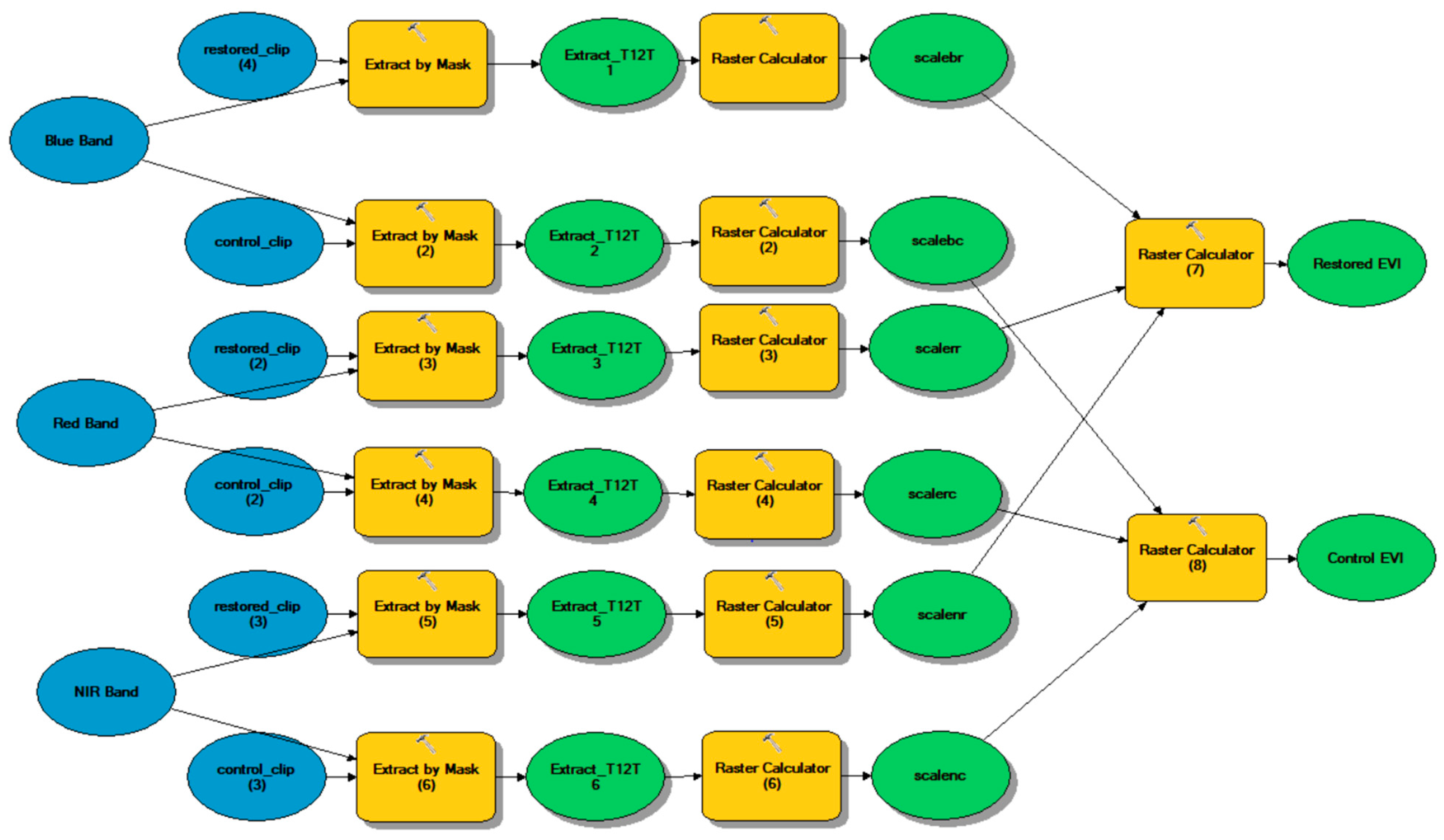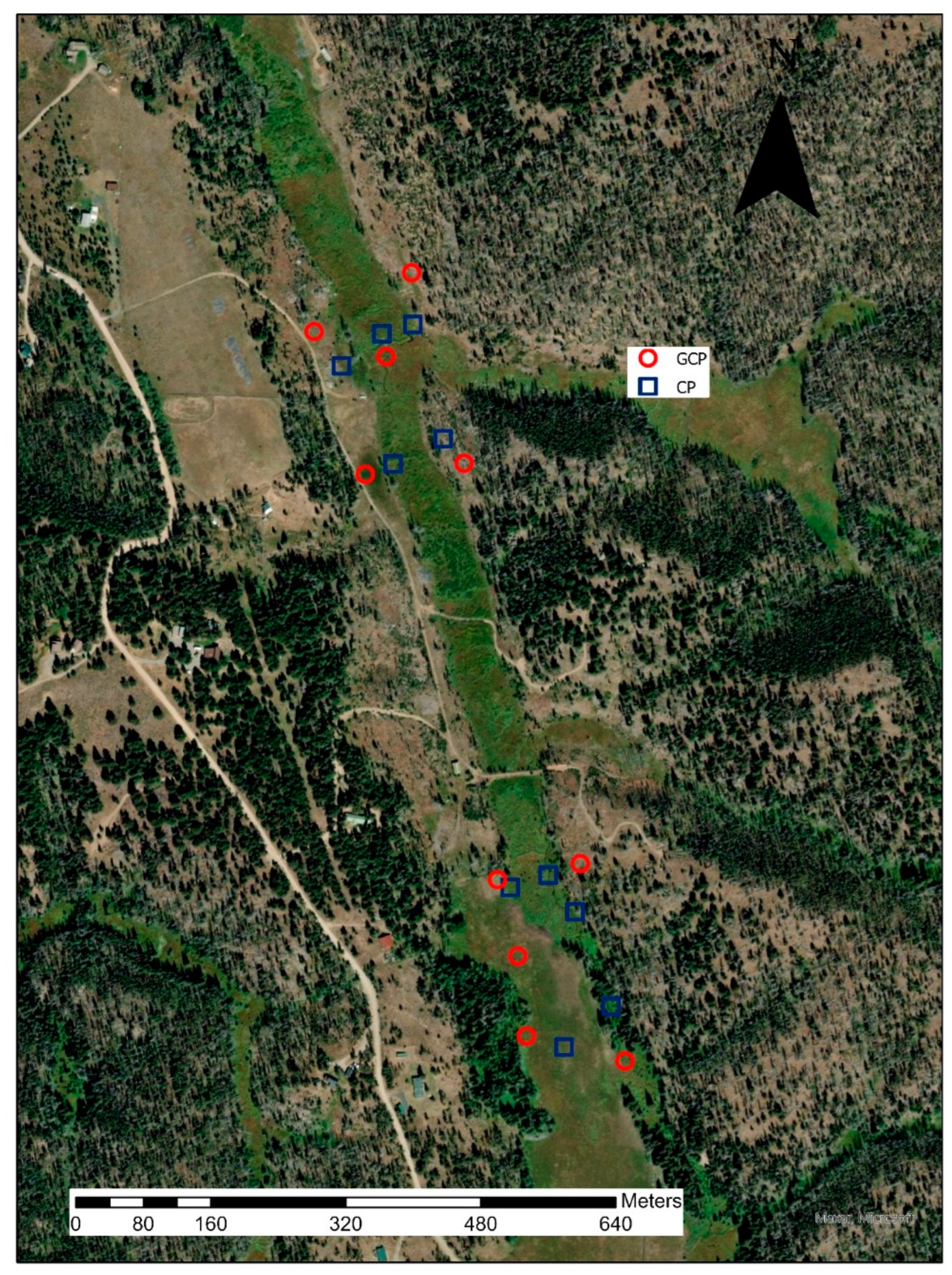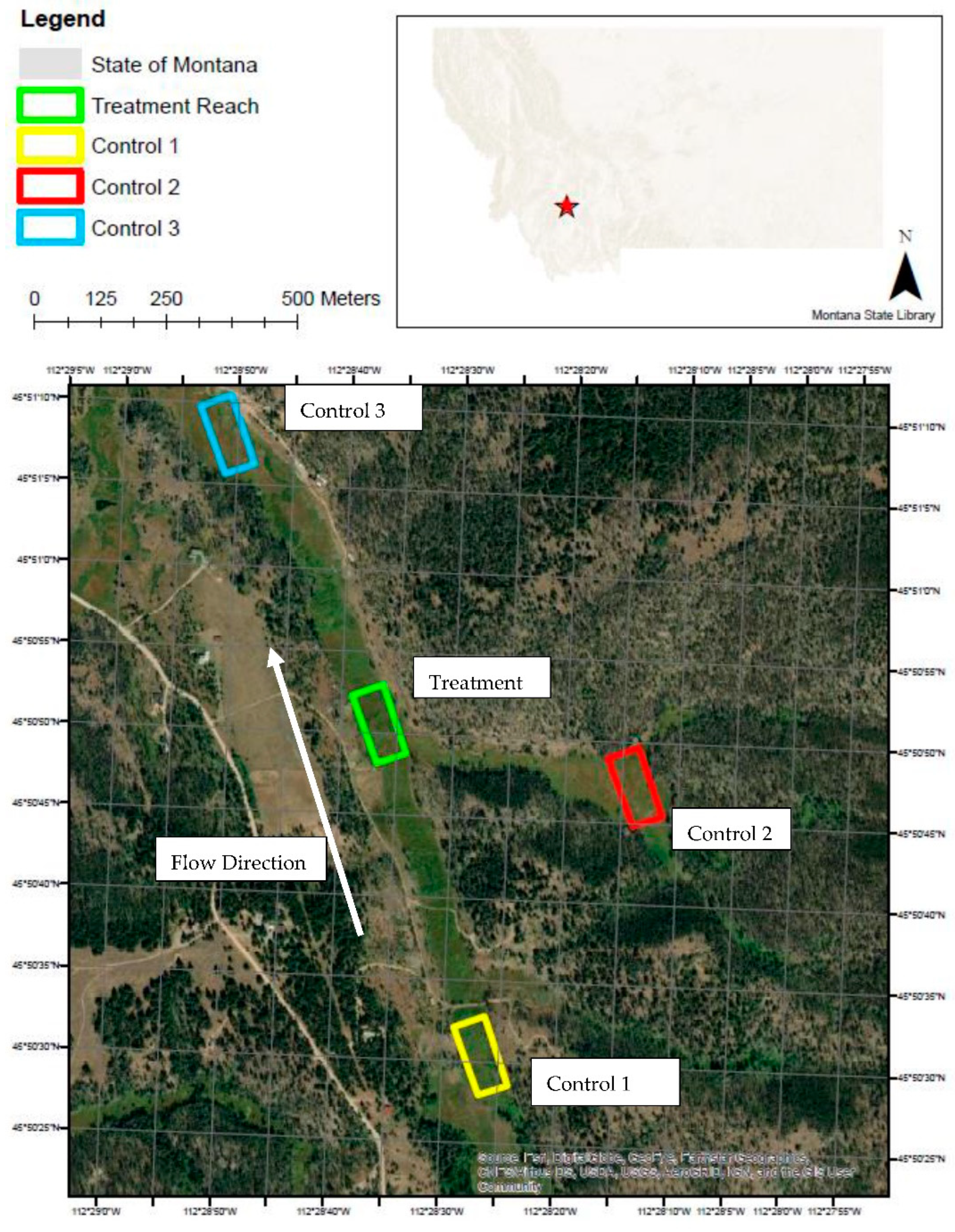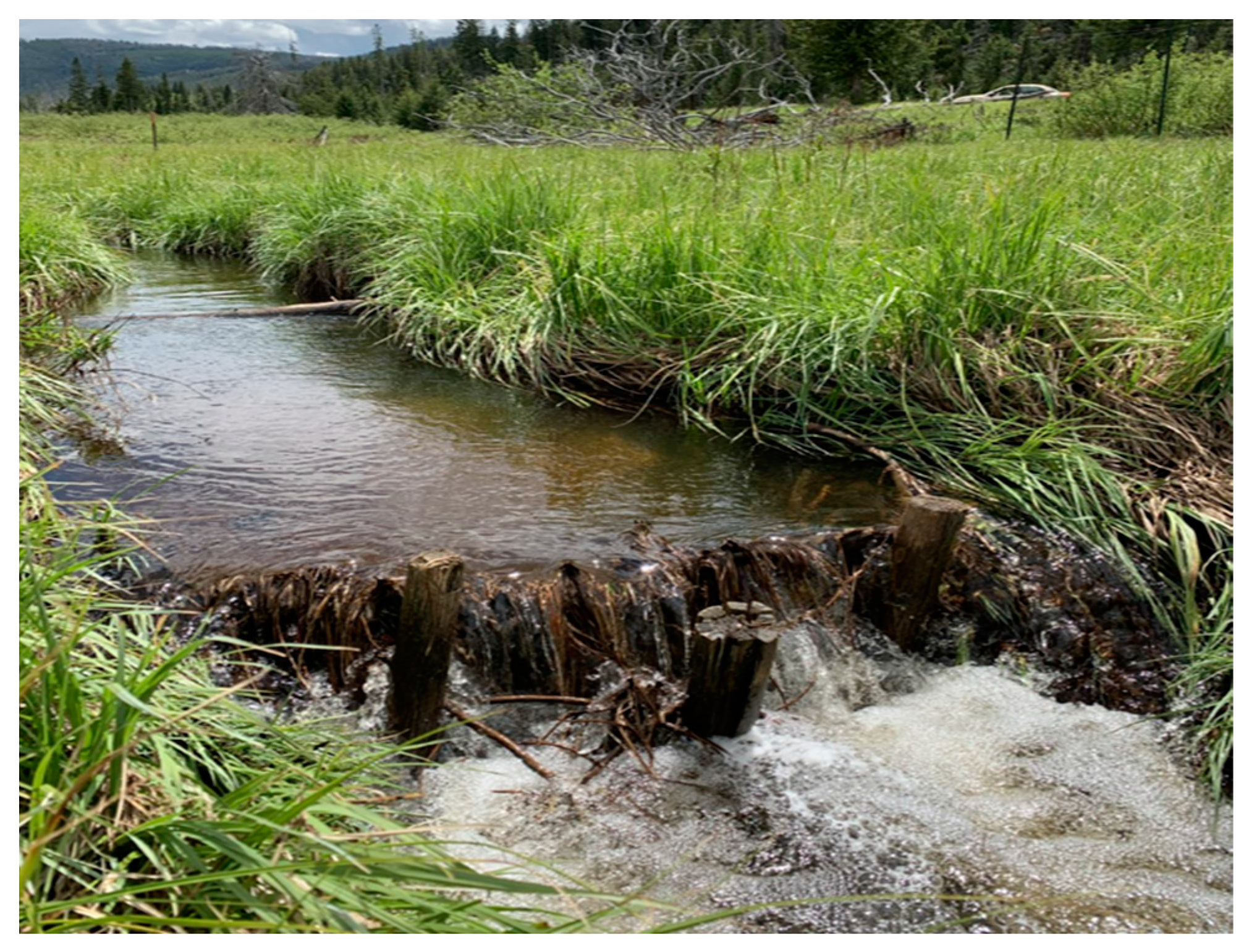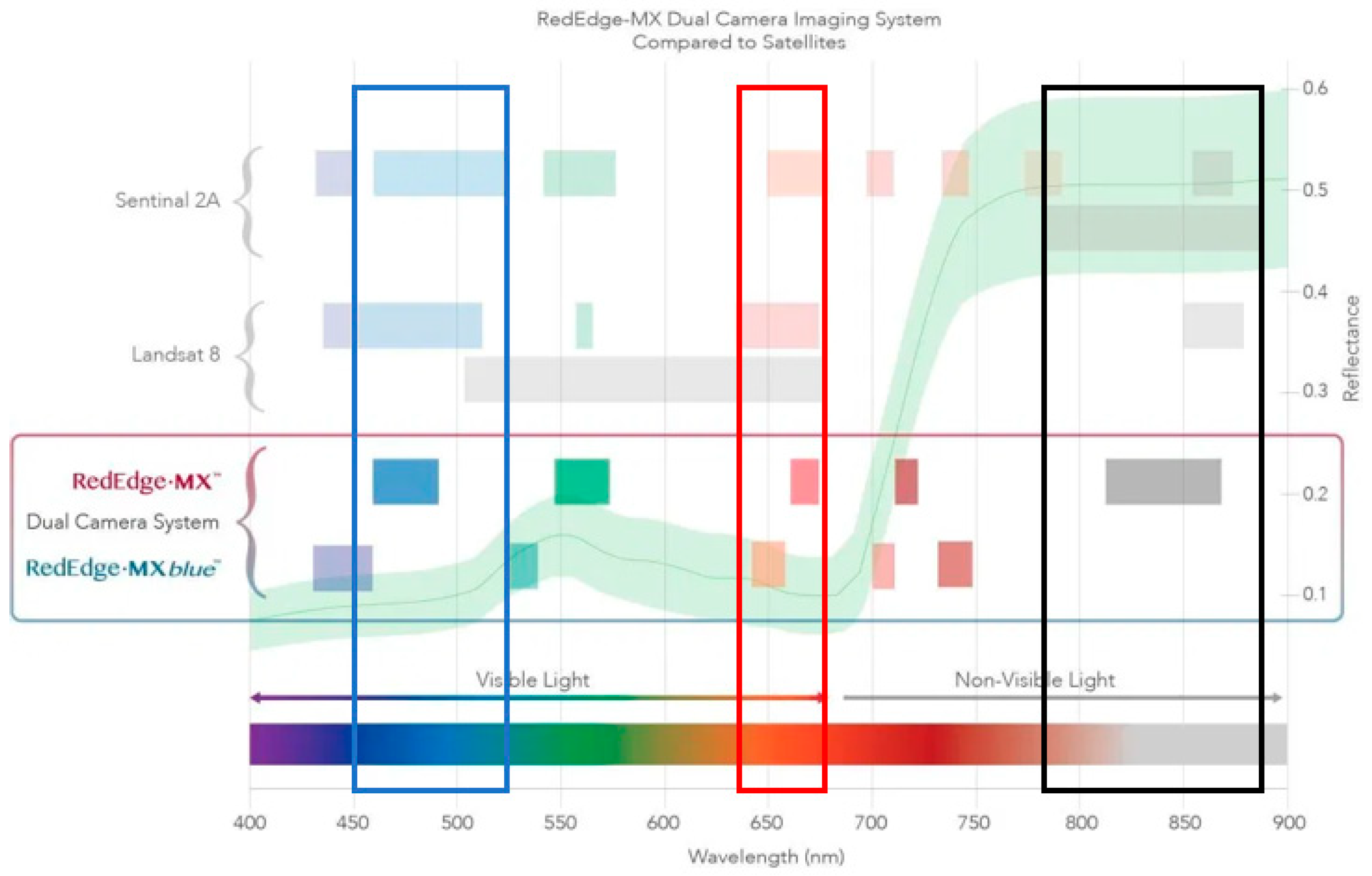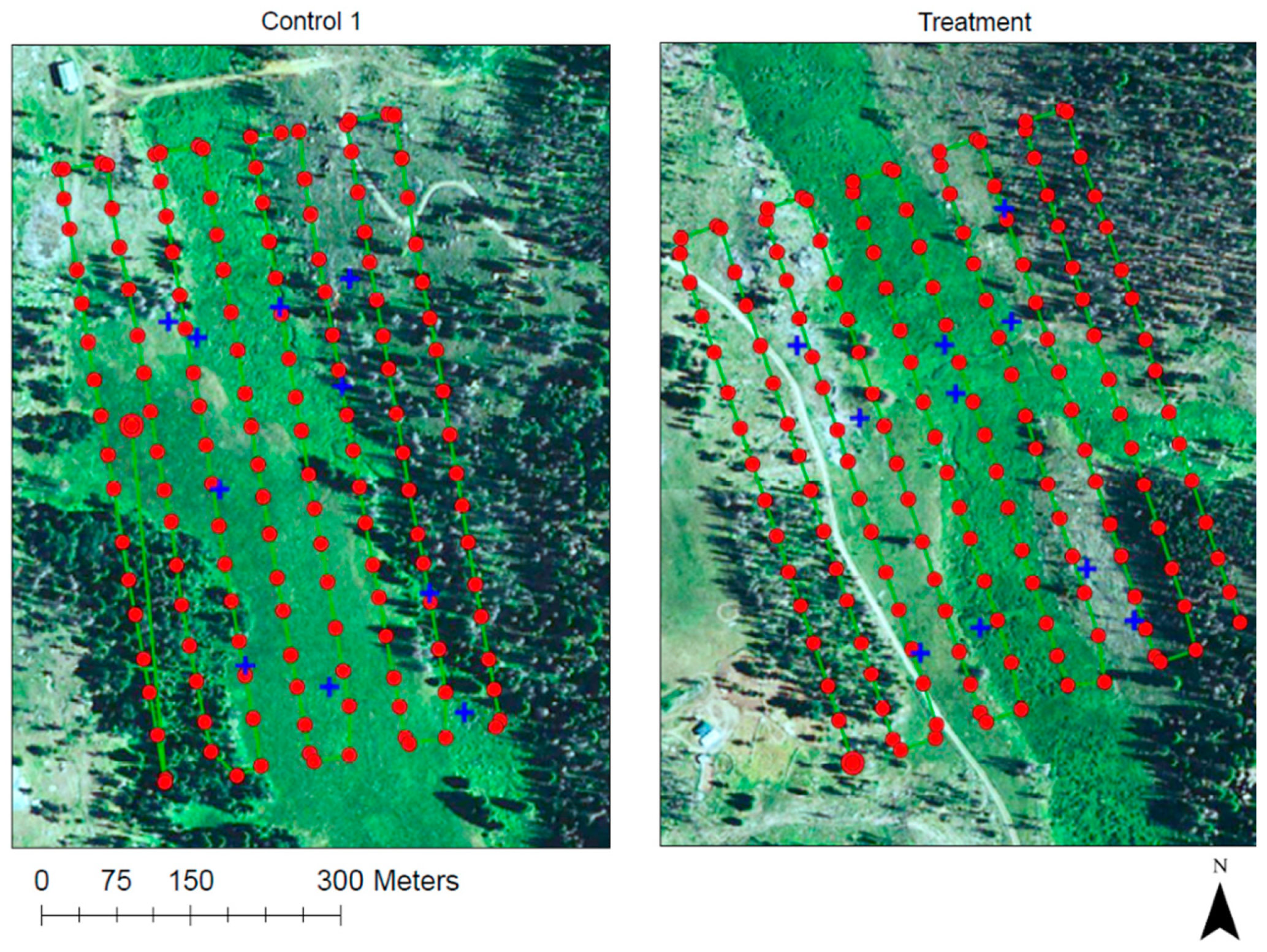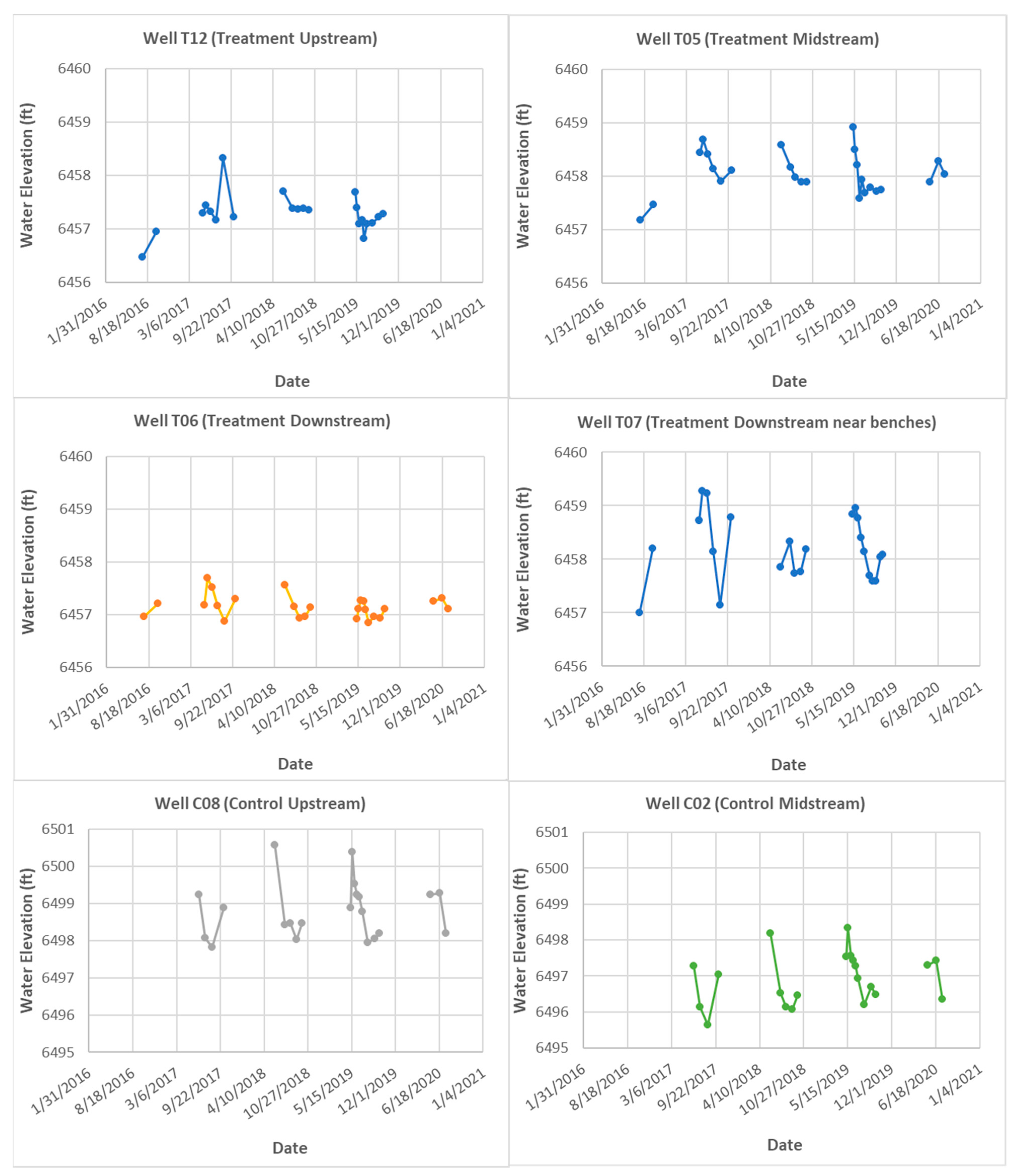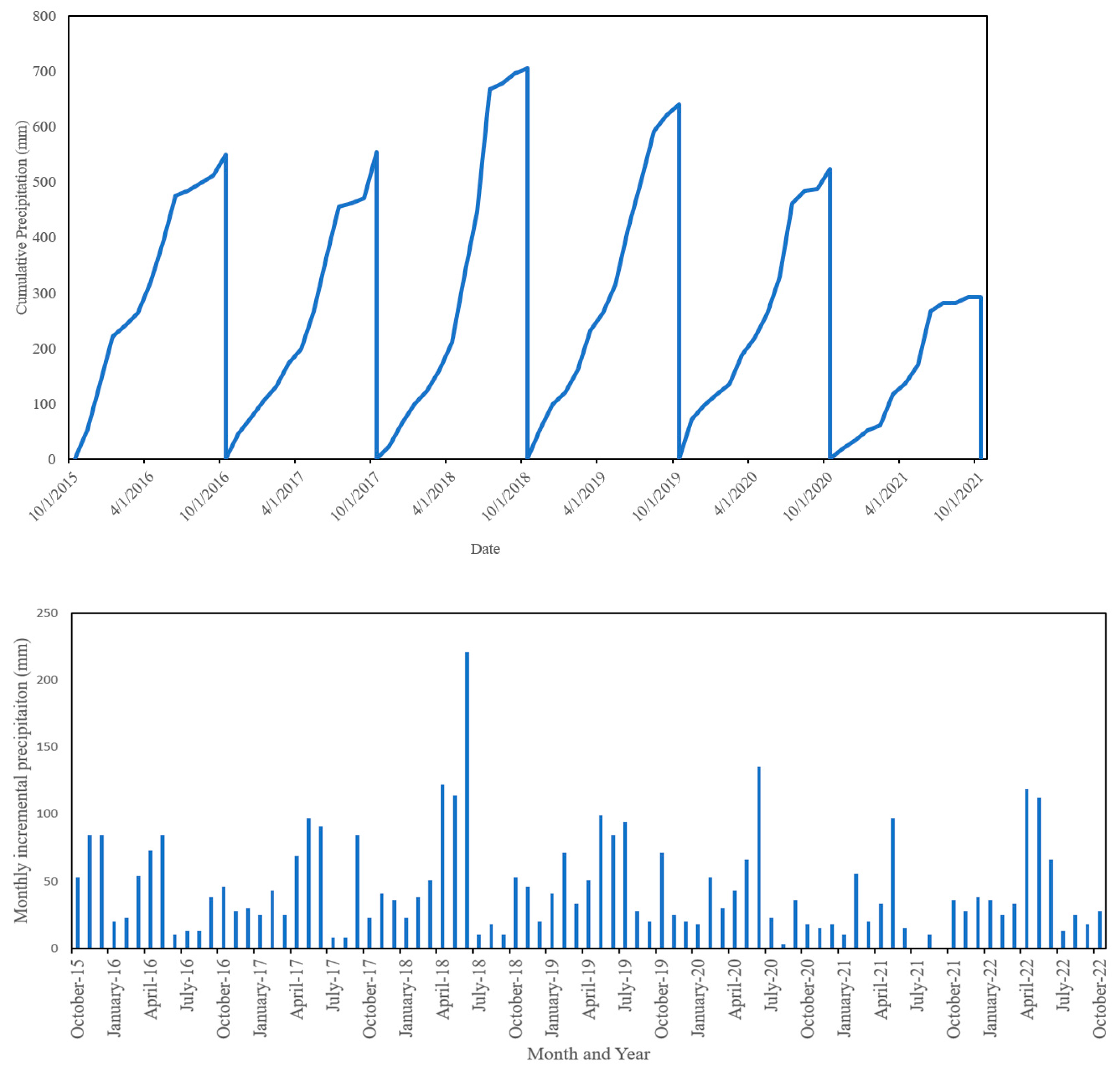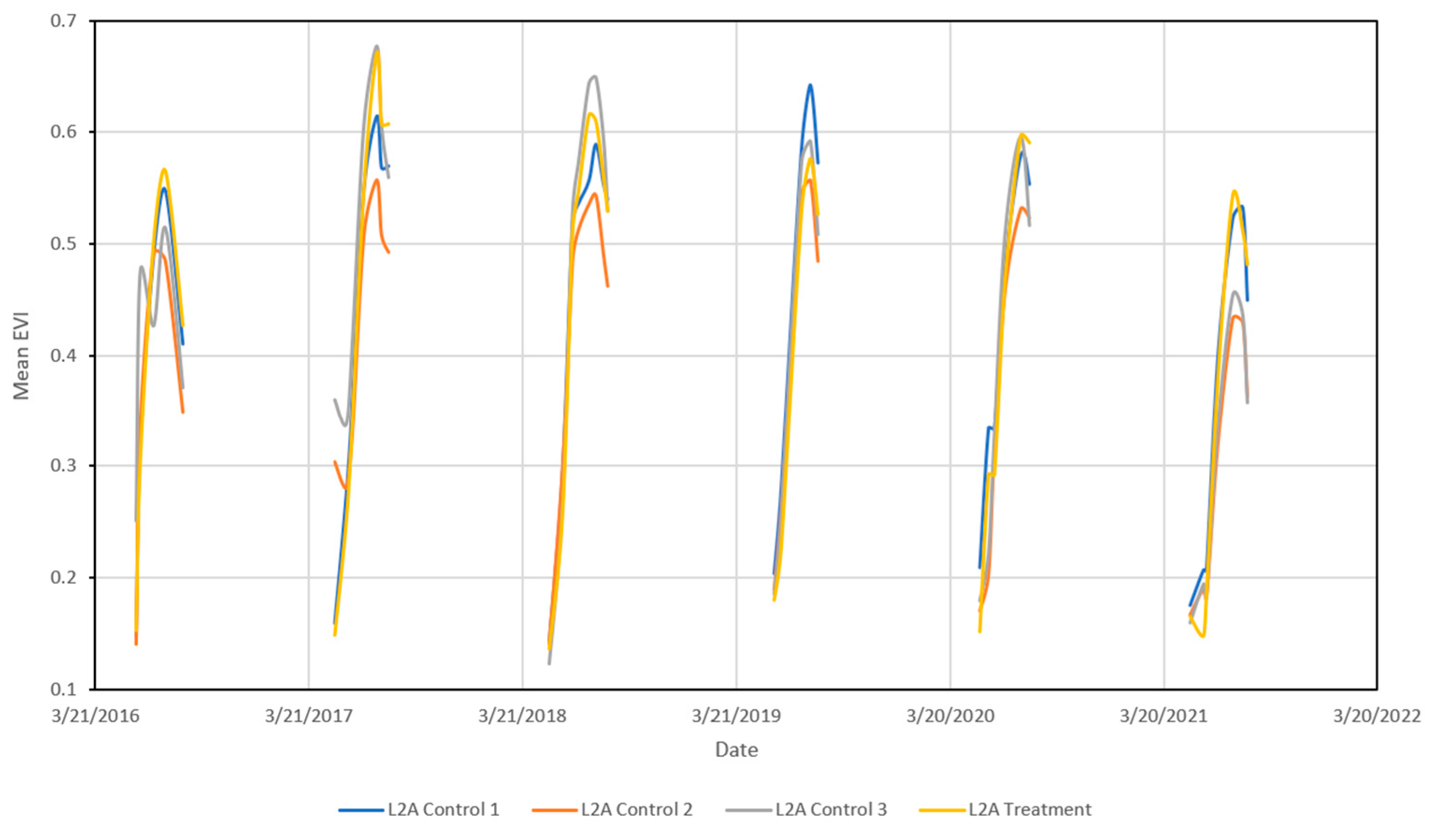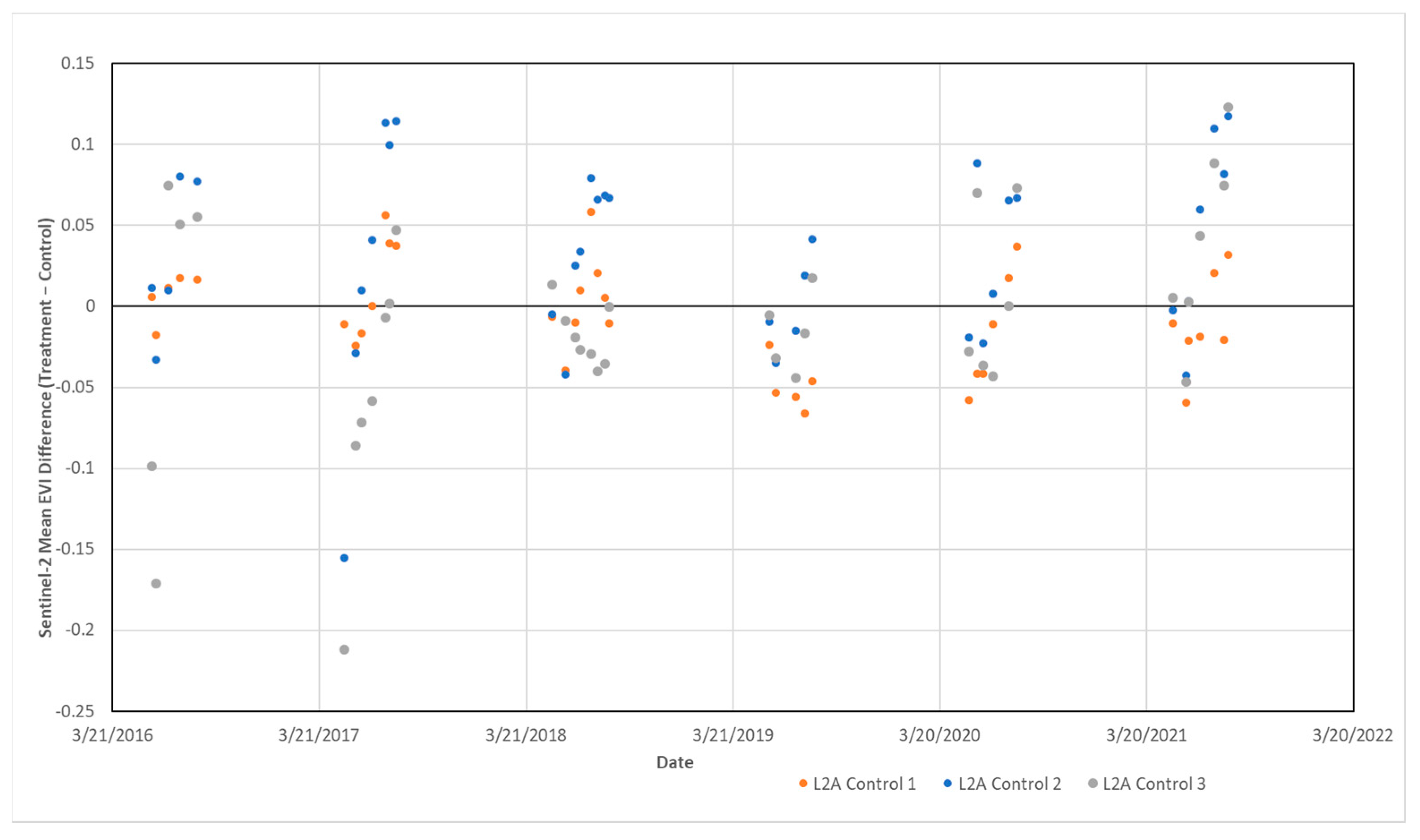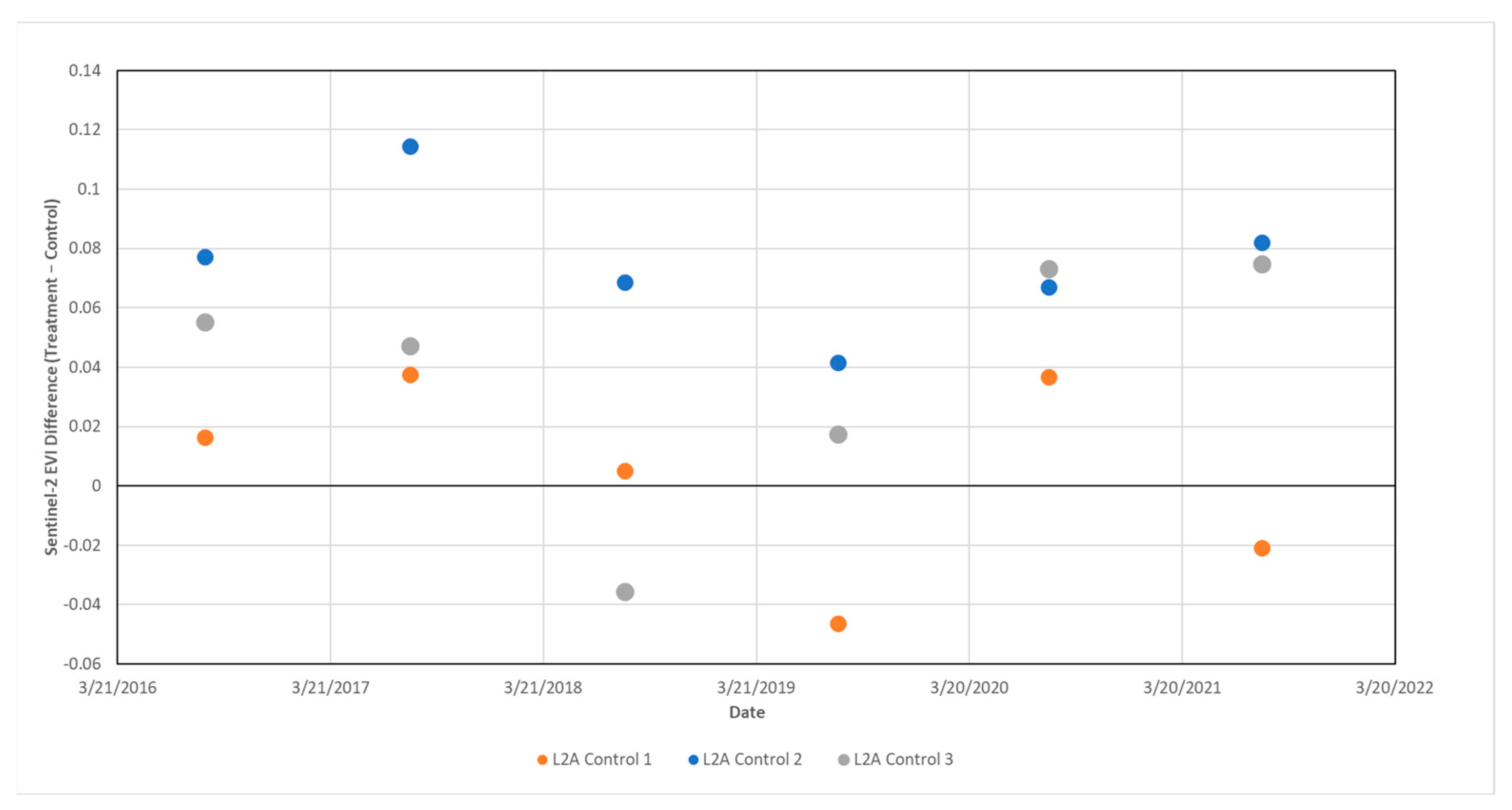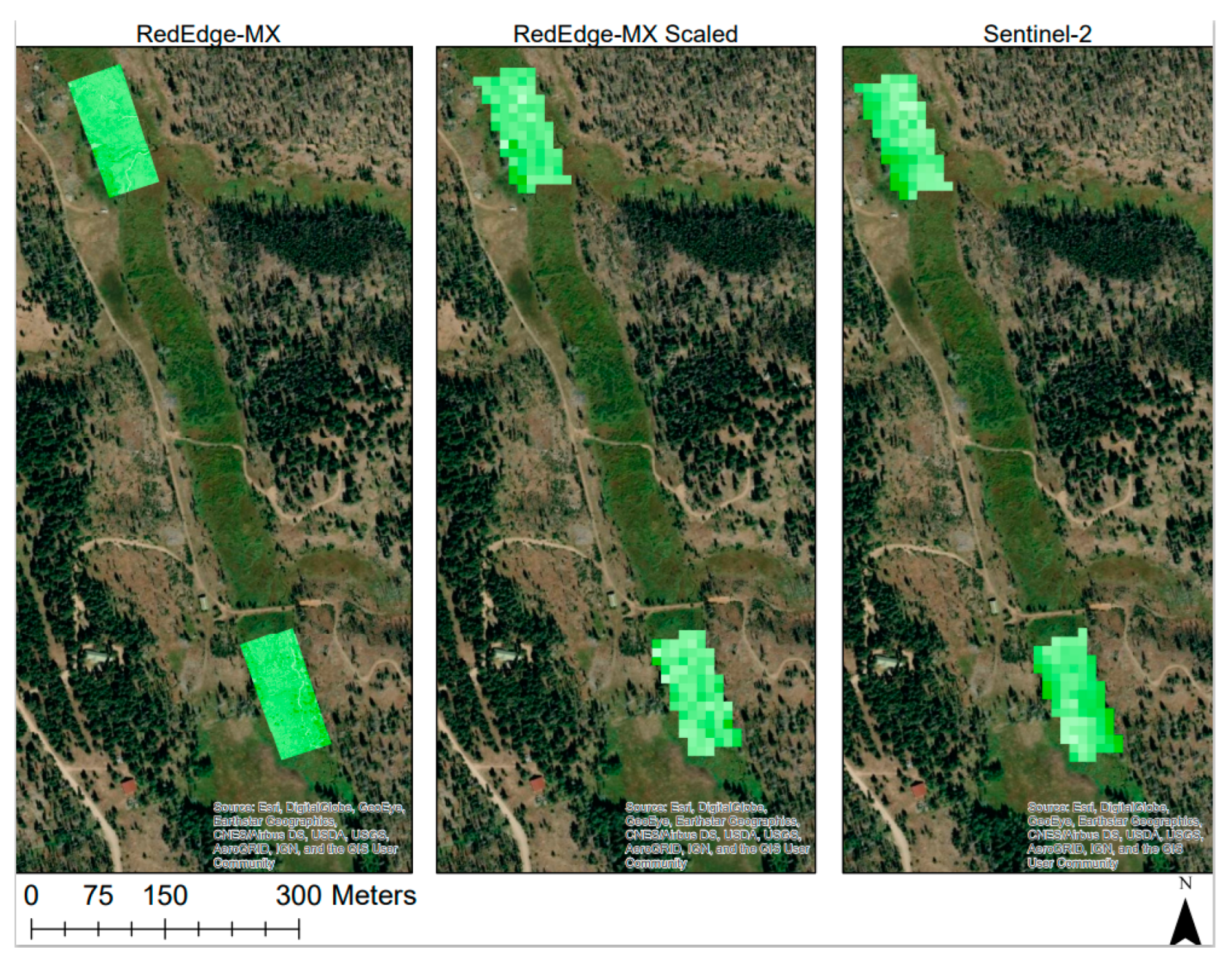Author Contributions
Conceptualization, R.M.N., E.A. and A.L.B.; methodology, R.M.N., E.A., J.C. and A.L.B.; formal analysis, E.A., R.M.N., J.C., A.L.B., G.S. and J.F.; writing—original draft preparation, E.A., R.M.N., J.C., A.L.B. and G.S.; writing—review and editing, R.M.N., E.A., J.C., A.L.B. and G.S; supervision, R.M.N.; project administration, R.M.N.; funding acquisition, R.M.N. and J.C. All authors have read and agreed to the published version of the manuscript.
Figure 1.
Study Reach Locations.
Figure 1.
Study Reach Locations.
Figure 2.
Typical BDA restoration configuration. Photos taken post-treatment (19 June 2020).
Figure 2.
Typical BDA restoration configuration. Photos taken post-treatment (19 June 2020).
Figure 3.
Groundwater and surface water monitoring locations. (Left) Treatment reach. (Right) Control 1 reach.
Figure 3.
Groundwater and surface water monitoring locations. (Left) Treatment reach. (Right) Control 1 reach.
Figure 4.
Spectral reflectance band comparison of dual camera system with Landsat 8 and Sentinel-2 (used with permission from MicaSense, Inc., Seattle, WA, USA). Colored boxes represent blue, red, and NIR wavelengths for each imaging system.
Figure 4.
Spectral reflectance band comparison of dual camera system with Landsat 8 and Sentinel-2 (used with permission from MicaSense, Inc., Seattle, WA, USA). Colored boxes represent blue, red, and NIR wavelengths for each imaging system.
Figure 5.
sUAS flight paths. Red dots represent individual captures and blue crosshairs represent geolocated ground control points and check points. (Left): Control 1 reach. (Right): Treatment reach.
Figure 5.
sUAS flight paths. Red dots represent individual captures and blue crosshairs represent geolocated ground control points and check points. (Left): Control 1 reach. (Right): Treatment reach.
Figure 6.
Groundwater elevations for wells in the treatment and control reaches on Blacktail Creek (data up to year 2019 are from Norman [
24]; 2020 data are collected as part of this study).
Figure 6.
Groundwater elevations for wells in the treatment and control reaches on Blacktail Creek (data up to year 2019 are from Norman [
24]; 2020 data are collected as part of this study).
Figure 7.
Basin Creek SNOWTEL station precipitation data. Top–Water year cumulative precipitation data (cumulative for water year beginning 1 October and ending 30 September). Bottom–Monthly incremental precipitation values.
Figure 7.
Basin Creek SNOWTEL station precipitation data. Top–Water year cumulative precipitation data (cumulative for water year beginning 1 October and ending 30 September). Bottom–Monthly incremental precipitation values.
Figure 8.
Sentinel-2 (May to August, 2016–2021) mean EVI values (level-2A, dimensionless) for treatment and control reaches.
Figure 8.
Sentinel-2 (May to August, 2016–2021) mean EVI values (level-2A, dimensionless) for treatment and control reaches.
Figure 9.
Sentinel-2 mean EVI difference (Treatment–Control, dimensionless) values.
Figure 9.
Sentinel-2 mean EVI difference (Treatment–Control, dimensionless) values.
Figure 10.
Sentinel-2 mean EVI difference (Treatment–Control, dimensionless) values for the month of August (dry season, when changes in water availability would be most apparent).
Figure 10.
Sentinel-2 mean EVI difference (Treatment–Control, dimensionless) values for the month of August (dry season, when changes in water availability would be most apparent).
Figure 11.
Spatial and temporal variation of EVI values in the study reach and control 1 reach.
Figure 11.
Spatial and temporal variation of EVI values in the study reach and control 1 reach.
Figure 12.
EVI raster images from Sentinel-2, RedEdge-MX dual camera system and scaled RedEdge-MX for treatment reach on 25 May 2020.
Figure 12.
EVI raster images from Sentinel-2, RedEdge-MX dual camera system and scaled RedEdge-MX for treatment reach on 25 May 2020.
Table 1.
Abbreviations and symbols.
Table 1.
Abbreviations and symbols.
| Abbreviations and Symbols | Meaning |
|---|
| AMSL | Above Mean Sea Level |
| BDAs | Beaver Dam Analogs |
| CPs | Check points |
| ET | Evapotranspiration |
| ETa | Actual evapotranspiration |
| ETo | Local reference crop evapotranspiration |
| EVI | Enhanced Vegetation Index |
| EVImax | 99.5 percentile value of the EVI data |
| EVImin | 0.5 percentile value of the EVI data |
| EVI*
| Rescaled EVI values |
| GCPs | Ground control points |
| NIR | Near Infrared |
| SfM | Structure from Motion |
| sUAS | small Unmanned Aerial System |
Table 2.
Wavelengths for Sentinel-2 and sUAS [
32,
33] remote sensing. NA refers to the cells where the sensor is not designed to collect the corresponding bandwidth data.
Table 2.
Wavelengths for Sentinel-2 and sUAS [
32,
33] remote sensing. NA refers to the cells where the sensor is not designed to collect the corresponding bandwidth data.
| | Sentinel-2 | Dual Camera System 1 |
|---|
| Band 1 | Coastal Aerosol (0.433–0.453) | Blue (0.459–0.491 µm) |
| Band 2 | Blue (0.458–0.522) | Green (0.547–0.574 µm) |
| Band 3 | Green (0.543–0.577) | Red (0.661–0.675 µm) |
| Band 4 | Red (0.65–0.68) | Red Edge (0.711–0.723 µm) |
| Band 5 | Vegetation Red Edge (0.698–0.712) | NIR (0.814–0.871 µm) |
| Band 6 | Vegetation Red Edge (0.733–0.747) | Coastal Blue (MX Blue) (0.430–0.458 µm) |
| Band 7 | Vegetation Red Edge (0.773–0.793) | Green (MX Blue) (0.524–0.538 µm) |
| Band 8 | NIR (0.785–0.899) | Red (MX Blue) (0.642–0.658 µm |
| Band 8a | Vegetation Red Edge (0.855–0.875) | NA |
| Band 9 | Water vapor (0.935–0.955) | Red Edge 1 (MX Blue) (0.700–0.710 µm |
| Band 10 | SWIR-Cirrus (1.36–1.39) | Red Edge 2 (MX Blue) (0.731–0.749 µm) |
| Band 11 | SWIR (1.565–1.655) | NA |
| Band 12 | SWIR (2.1–2.28) | NA |
Table 3.
Streamflow measurements for control 1 and treatment reaches (
Figure 3).
Table 3.
Streamflow measurements for control 1 and treatment reaches (
Figure 3).
| Control | 10 May 2020 | 19 June 2020 | 19 July 2020 | 23 August 2020 | Treatment | 10 May 2020 | 19 June 2020 | 19 July 2020 | 23 August 2020 |
|---|
| Name | Flow (m3/s) | Flow (m3/s) | Flow (m3/s) | Flow (m3/s) | Name | Flow (m3/s) | Flow (m3/s) | Flow (m3/s) | Flow (m3/s) |
| SW_UC | 0.054 | 0.113 | 0.030 | 0.017 | SW_UT | 0.045 | 0.102 | 0.032 | 0.018 |
| SW_DC | 0.050 | 0.105 | 0.031 | 0.023 | SW_M1T | 0.058 | 0.098 | 0.037 | 0.016 |
| | | | | | SW_M2T | 0.060 | 0.129 | 0.044 | 0.016 |
| | | | | | SW_DT | 0.062 | 0.141 | 0.045 | 0.015 |
Table 4.
Statistics for sUAS multispectral flights: sample size (n) and root mean square error (x, y, and z) in geolocation of multispectral products for ground control points (GCP) and check points (CP).
Table 4.
Statistics for sUAS multispectral flights: sample size (n) and root mean square error (x, y, and z) in geolocation of multispectral products for ground control points (GCP) and check points (CP).
| Date | Study Location | Ground Sampling Distance (cm) | RMSE for GCPs | RMSE for CPs |
|---|
| n | X (cm) | Y (cm) | Z (cm) | n | X (cm) | Y (cm) | Z (cm) |
|---|
| 10 May 2020 | Control | 8 | 5 | 2 | 1 | 1 | 5 | 5 | 3 | 6 |
| Treatment | 8 | 5 | 1 | 1 | 2 | 5 | 3 | 1 | 9 |
| 19 July 2020 | Control | 9 | 5 | 2 | 1 | 2 | 5 | 3 | 4 | 14 |
| Treatment | 8 | 5 | 1 | 1 | 1 | 5 | 4 | 1 | 19 |
Table 5.
Summary of images processed, area covered, median keypoints per image, calibrated images, and median matches per image for sUAS multispectral orthomosaic.
Table 5.
Summary of images processed, area covered, median keypoints per image, calibrated images, and median matches per image for sUAS multispectral orthomosaic.
| Date | Study Location | Number of Images | Area Covered (ha) | Median Keypoints Per Image | Calibrated Images | Median Matches Per Calibrated Image |
|---|
| 10 May 2020 | Control | 740 | 12.5 | 10,000 | 100% | 5651 |
| Treatment | 820 | 12.5 | 10,000 | 98% | 5922 |
| 19 July 2020 | Control | 715 | 12.6 | 10,000 | 100% | 5062 |
| Treatment | 820 | 14.0 | 10,000 | 100% | 5186 |
Table 6.
Comparison of EVI values, calculated using ArcMap, between the RedEdge-MX, the RedEdge-MX pixel scaled to 10 m, and Sentinel-2 Level-2A data for 10 May 2020 and 19 July 2020.
Table 6.
Comparison of EVI values, calculated using ArcMap, between the RedEdge-MX, the RedEdge-MX pixel scaled to 10 m, and Sentinel-2 Level-2A data for 10 May 2020 and 19 July 2020.
| | | RedEdge-MX | RedEdge-MX Scaled | Sentinel-2 |
|---|
| | | Control | Restored | Control | Restored | Control | Restored |
|---|
| 10 May 2020 | Minimum | −0.013 | −0.014 | 0.045 | 0.025 | 0.155 | 0.125 |
| Maximum | 0.715 | 0.576 | 0.530 | 0.213 | 0.303 | 0.171 |
| Mean | 0.152 | 0.121 | 0.148 | 0.119 | 0.209 | 0.151 |
| Std. Dev. | 0.069 | 0.025 | 0.061 | 0.026 | 0.033 | 0.009 |
| 19 July 2020 | Minimum | 0.036 | −0.026 | 0.202 | 0.202 | 0.436 | 0.505 |
| Maximum | 0.901 | 0.947 | 0.823 | 0.835 | 0.667 | 0.667 |
| Mean | 0.552 | 0.610 | 0.565 | 0.605 | 0.579 | 0.596 |
| Std. Dev. | 0.136 | 0.114 | 0.136 | 0.100 | 0.061 | 0.036 |
Table 7.
EVImax, EVImin, and ETo, for sUAS flights on 10 May 2020 and 19 July 2020.
Table 7.
EVImax, EVImin, and ETo, for sUAS flights on 10 May 2020 and 19 July 2020.
| | | Control | Treatment |
|---|
| 10 May 2020 | EVImax (unitless) | 0.608 | 0.406 |
| EVImin (unitless) | 0.019 | 0.005 |
| ETo (mm/d) | 4.4 | 4.4 |
| 19 July 2020 | EVImax (unitless) | 0.821 | 0.859 |
| EVImin (unitless) | 0.091 | 0.124 |
| ETo (mm/d) | 4.9 | 4.9 |
Table 8.
Descriptive statistics for estimated evapotranspiration values for sUAS flights 10 May 2020 and 19 July 2020.
Table 8.
Descriptive statistics for estimated evapotranspiration values for sUAS flights 10 May 2020 and 19 July 2020.
| | | Evapotranspiration Values (mm/d) |
|---|
| | | Control | Treatment |
|---|
| 10 May 2020 | Min | 0 | 0 |
| Max | 5.75 | 5.75 |
| Mean | 2.03 | 2.7 |
| 19 July 2020 | Min | 0 | 0 |
| Max | 6.40 | 6.61 |
| Mean | 5.13 | 5.32 |
